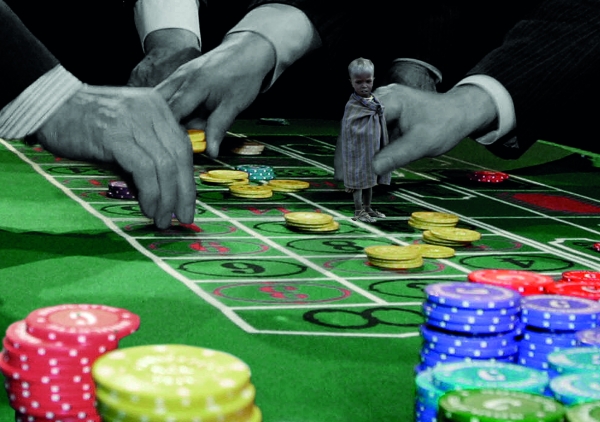Unofficial War Artist: Peter Kennard at the IWA

“The people’s peace museum” is Peter Kennard’s suggested name change for the Imperial War Museum, where his stunning images are currently on display. If Kennard ever does get his way on that one, it will be partly thanks to his 50-year artistic campaign of militant anti-war and anti-capitalist activism, the subject of this well-designed retrospective exhibition of over 200 of his artworks.
They make their impact through the cutting, pasting and juxtaposition of photographic images in ways which deliver striking and unsettling artistic and political messages.
Kennard turned to photomontage as a young art student because, he says, he could “rip into images and get at an unrevealed truth” for maximum aesthetic and political impact. Interventionist and activist, he has doubts about art “so layered with complex conceptual ideas that it only speaks to others in the art world.” Instead, he’s opted for an art form which he wants to use “to help build a mass movement.”
The exhibition’s powerful opening statement Decoration is a series of massive digital and painted prints of British and US war decorations from 2003, their ribbons ripped and their medallions replaced with images of bandaged heads, explosions and hooded Iraqi prisoners.
Following on, there are early montages referencing the Vietnam war, the “Prague spring” and the student riots of the late sixties and they have that provocative, deliberately disorienting and distancing effect which runs throughout his work.
On display in an “archival store” are his works Crushed Missile, Haywain with Cruise Missiles and Warheads in the form of posters, T-shirts, pamphlets, badges and placards.
These and other direct, simple and sardonic images are what Kennard described as “a toolkit of protest” which are reworked and used freely by the peace movement, student activists and anti-corporate groups. Kennard has always tried to make his art accessible and useful to Britain’s protest movement, in its form and in the way it is distributed.
Reading Room, an installation where lecterns are laid out with faces smudged onto the stock market reports from the financial pages, graphically illustrates the growing dominance of finance capitalism in the 1990s and the resulting social inequalities. On the walls financial pages are ripped and defaced in anger, frustration or, perhaps, revolutionary destructiveness.
A side corridor, lined with some of Kennard’s latest paintings, contains subtle, indistinct images of faces with no mouths, expressing his desire to “give voice to the speechless and marginalised.”
The concluding display Boardroom is a new installation. It’s an ambitious attempt to convey anti-capitalist, anti-militarist political messages through a series of 3-D montages of photographs, models and images, interspersed with facts and figures showing the connections between war, capitalism and poverty.
Their impact is akin to Bertholt Brecht’s “alienation effect” by engaging and shocking the viewer into seeing the truth by stripping away dominant ideological mystifications and denying comfortable illusions. Kennard’s work invokes astonishment and outrage by placing and re-placing images and events in unfamiliar contexts.
This is work exposing the ugliness of corporate capitalism, including its sponsorship of art. “Now we’ve got the unmentionables back in power,” Kennard says, “sponsorship will become much more important in the arts. And sponsors like bland and unthreatening messages, not focused, political artwork.”
In a sense, art itself is anti-capitalist, he asserts. But “self-expression is being pushed out of us by big corporations. Creativity can help us resist that, so it’s important for all of us to make and use art to resist and undermine corporate culture. Through changing consciousness, art can help create revolution.”
The best example of such politically effective art is probably the famous image — made jointly with Cat Phillipps — of Tony Blair grinning as he takes a selfie in front of a blazing oilfield in Iraq. Recently animated and projected onto the venue housing the Chilcot inquiry, it is an image which has helped define an understanding of Blairite foreign policy.
Confined as it is to a museum, the exhibition can’t possibly include all of Kennard’s site-specific interventions such as that projected image, the graffiti on the Palestinian Wall that he did with Banksy or the huge amount of work given to the Occupy movement and to student activists a couple of years ago.
Yet the very presence of this free exhibition for the next 12 months in the country’s main war museum, where it will be seen by thousands of people who may not otherwise visit an art gallery, is surely the most effective intervention possible by Britain’s most important, influential and inventive political artist. And regular reader of the Morning Star, of course.
The exhibition runs till May 2016
https://mail.culturematters.org.uk/index.php/arts/visual-art/item/2169-unofficial-war-artist#sigProId1d46fcfbc1

Mike Quille
Mike Quille is a writer, reviewer and chief editor of Culture Matters.

